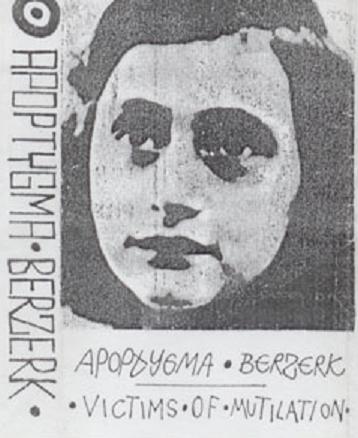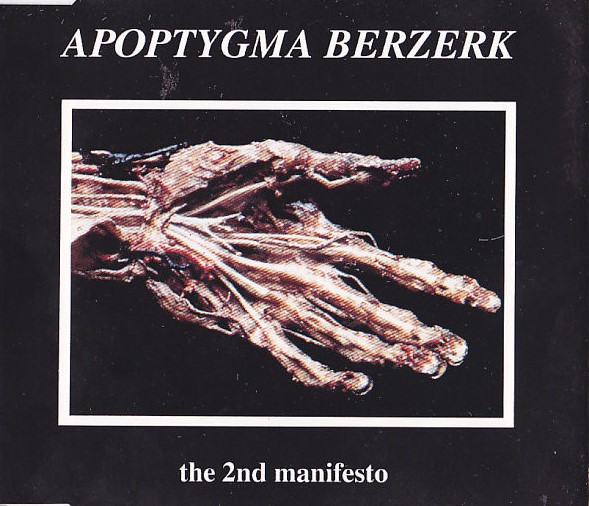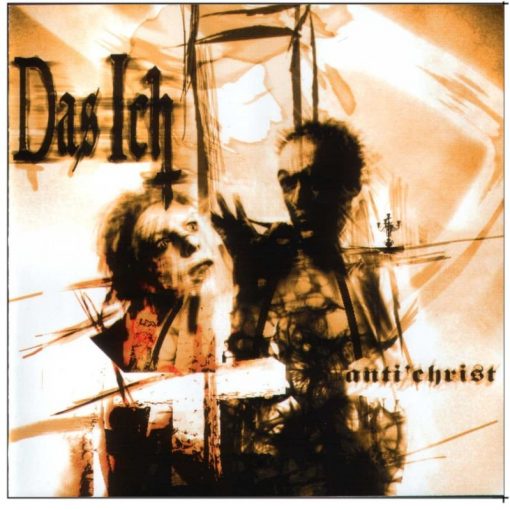This guide comes after a lengthy break in my long-form writing. In order to get back on track, I realised I had to cover a band where I could really spin a tale, both in terms of the band’s own history and how their music affected me. And when I think back to which band broke the Anglo-American dominated nature of my CD collection back in the late 1990s and dragged me willingly into the ‘scene’ that has dominated my life ever since, Apoptygma Berzerk are the band most responsible.
The name means little to many, indeed it means nothing at all in linguistic terms. However, behind that incomprehensible name is a fascinating, diverse, sometimes frustrating project, one who’s never afraid to state its influences, but always willing to take them in a variety of directions. It is a project of many facets, many influences and many motivations, and hence despite not having the largest backcatalogue of all the bands I’m planning to cover, it’s still my longest Listener’s Guide to date.
Apop (as they will often be referred to from here, APB is also a valid shorthand) have had a fluid line-up, but at the heart of the project is Stephan Groth. Born in Denmark but of Norwegian nationality, having resided there since adolescence, he is the driving force and one constant factor in the story I’m about to tell. The albums do feature the other members on occasion, more frequently in their mid-late-00s era, and there’s always a multitude of guest players. For instance, Stephan’s brother Jonas gets a significant number of credits throughout the band’s history, but only officially joined the live band in 2009 as keyboardist. It’s confusing if you’re trying to track who’s-playing-on-what, but for now, just don’t forget who’s in charge!
A Note On Format
Apop’s discography can initially appear to be a confusing mix of albums, singles, EPs and DVDs. It’s common for the same tunes and versions to crop up on multiple releases, several years apart. This will be of little concern to those of you who now enjoy your music via streaming services, but completist physical-format collectors will have their hands full. I’ll be taking a middle track on this aspect, summing up the key tracks era-by-era and the most effective route to collecting them. Comprehensive but not exhaustive – check out Discogs.com if you want the final gaps filled.
One difference from other listeners guides will be that all the singles and EPs will be described as part of the main text, due to their significance in tracing the creative history of the project. So the ‘Singles and Versions’ section after each album will be, in this case, just ‘Versions’. Shortcuts to collecting them all will be covered in ‘Apop Collected’.
I’m Not Afraid To Die
Apoptygma Berzerk began in 1989 as a collaboration between Stephan Groth and Jon Erik Martinsen (though Jon left the project before this paragraph even ends). Their initial output was the demo tape Victims of Mutilation. Far removed from the band we know and (hopefully) love today, this is bedroom-quality EBM of the old-school variety. Now mainly of curiosity interest for two reasons – the existence of a track actually called Apoptygma (no further clues) and the first of several versions of Ashes To Ashes, the only track on this demo to be reworked at later date – more than once, in fact.
This demo was sufficient to get the Tatra label interested and the first official Apoptygma Berzerk release arrived in 1991 – the Ashes To Ashes 12” single. A throbbing bassline that could have been lifted from That Total Age, a vocal snarl from the Skinny Puppy school, offset against heavenly synths that until now simply didn’t belong in this style of music. The B-sides were less memorable – Wrack’em to Pieces takes vocals into extreme metal territory (wrong kind of Norweigan influence) and Dust to Dust tries for a cleaner vocal and something approximating to a xylophone solo but isn’t developed as far as it could have been.
The project got more attention after providing a couple of tracks to the 1992 ‘Sex, Drugs and EBM’ compilation – the techno-inspired Borrowed Time and the first of several versions of Burning Heretic – full of gothic melodies and religious reference, it was the basis for the Apop sound of the 1990s, introducing Stephan’s more ‘natural’ vocal style, which, whilst no sign of true virtuosity, served him well across the many variant subgenres he’d later explore. The concept was developed fully on EP The Second Manifesto. The medieval intro leads into Spiritual Reality. The hammering beat and mechanical bassline wasn’t unlike the kind of thing Project Pitchfork were playing at the time, but Groth’s musings about his own faith and mortality made this tune very much one of his own. Burning Heretic also appears here in it’s “Gothic Version”, stripping out the drums and bringing it’s distinctive synth riff to the fore, it’s like 90s darkwave-meets-John Carpenter.
1993 saw the release of Bitch – aimed firmly at the dancefloors, it’s a hard-hitting, dismissive “take a swipe at the ex” tune, but it’s assembled with sufficient maturity to forgive a subject matter too often the subject of musician’s “early works”. Backed with equally gutsy versions of “Ashes To Ashes” and “Borrowed Time”, the single is a prelude to the first full-length Apop album Soli Deo Gloria. Stephan Groth has never exactly kept his religious background a secret, but a debut album that translates to “Glory To God” is certainly a case of wearing one’s heart on sleeve. Be assured, however, that he’s no bible basher either, and it’s just as well, because this album is enjoyable by people of all backgrounds, faiths and denominations.
“Bitch” and “Spiritual Reality” appear here in their original forms, and that’s no bad thing as it’d be hard to improve on either. There’s a new version of “Burning Heretic”, the melodies lighter in tone allowing the rhythmic elements to drive the song forward, and even leaving some space in the mix for a thrashy guitar riff! This would become the definitive version of this tune, a regular in their live sets. “Ashes To Ashes” in it’s ’93 form remains the full-throttle slam it always was, though with an improved standard of recording, it too can be seen as the definitive amongst many versions.
There are new tracks too. Backdraft revisits the jackhammering drums and spiritual musings of “Spiritual Reality”, and is just as good at doing so. ARP (808 Edit) is a brief analogue synth indulgence whilst Stitch takes a dip into slow, seething electro-industrial (harsh vocal tracks were never this projects strong point). The only really weak track is Skyscraping (Schizophreniac), which crudely bolts together a few half-developed ideas and passes them off as a single track. Mention must also be made of the four instrumental pieces that link this album together – such things are usually filler at best, but here they really help with the flow of album and make it work as a complete piece – rare on a full length debut.
And finally, we hear the beginning of an Apop trend. Cover versions. The obvious’ 80s standards would be saved for later. For now, New York legends The Velvet Underground get the APB treatment, with a radical overhaul of All Tomorrows Parties. Taking the basic pattern of original but totally reworking the instrumentation to fit with the style of the album as a whole, it’s a refreshing break from the near-soundalike-just-a-bit-angrier covers pervading this genre.
Versions: The album has been reissued several times in various formats. The issues from the 00s usually have three bonus tracks – a version of Burnin’ Heretic very similar to the album version despite a new vocal, also a couple of other ‘Ok-but-not-necessary’ alternate versions’. ARP unplugged just loses what was good about the original.
The 25th anniversary edition is the one you want – full remaster and seven bonus tracks, some from EPs and compilations, others never heard before. Two of them are yet-more takes of “Ashes To Ashes”, for those of you interested in the early evolution of this project in terms of what made it in and what was rejected. The other two are remixes – interlude track “The Sentinel” gets drawn out to three times it’s original length by Blackhouse, whilst allied Norwegians Technomancer provide a modernised but respectful take on “Backdraft”, bringing in their own sounds without killing the spirit of the original.
Apop’s next release was the Deep Red single in 1994 – the throbbing bassline and vocal snarl aren’t that far removed from the more club-friendly tracks on the last album (indeed they reprised “Backdraft” as a B-side), though with richer, more developed production style. There’s another new track in the form of Electronic Warfare, a no-holds-barred blast though up-tempo rhythms and shouted lyrics, but despite many variations on it’s core theme, it’s not an ‘stayer’ when measured alongside their other output of the time.
More significant was Non-Stop Violence the following year, the intense catchy synth groove bearing a strong anti-war message, particularly in terms of it’s media portrayal. It refers to both the conflicts in the former Yugoslavia (then still a significant news item) and Stefan’s own battle with the Norwegian authorities over the issue of forced military service, adding real meaning to that already memorable “Catch Me If You Can” chorus. Extras include a live version of “Burnin’ Heretic” (like the studio version with some extra guitar) and “Near (Banilla Dream Version)”, a track that gives a fairly substantial clue to what awaits us on the next full-length album.
Namely, 7, released in 1996. “Deep Red” makes it here intact, alongside a conceptually similar (but-just-as-good) Half Asleep. However, “Non-Stop Violence” has been extended, featuring a false ending and an outro that puts a further perspective on the song’s meaning. But if you want the real statement of intent, it’s found on Love Never Dies Part 1. The pipe organ intro gives way to that distinctive ascending synth line, with Stephan’s verses leading into THAT chorus, lifted straight from “O Fortuna”. In our relatively small, self-contained scene, it’s an anthem among anthems, featuring as it did in many of my highest-profile DJ sets – but unlike most of the others, it’s the kind of tune “normal people” like as well. Can’t remember how many people borrowed the CD in my Uni Halls of Residence off the back of this tune alone.
And the surprises don’t stop. “Near” has become Nearer, now heard in its definitive form, and it stands as one of Apop’s best slow, drawn-out synth-ballads, a formula they’d mess up more than once later in the tale. 25 Cromwell St. is the “other” kind of slow song, a dark, seething number with stabbing synth and scathing vocals delivered as a final fuck-you to Fred West, that very British of serial killers. Mourn pays reference to Apop’s rock influences, both with an acoustic drum track and its sample of Nirvana-covering-Bowie, as if to get a two-legends-for-the-price-of-one reference in.
There’s a couple of tracks that pale in comparison to the above (though they’re not exactly bad) – Rebel meanders too much and Love Never Dies Part 2 is an acoustic strum that pales in comparison to the first part. But this is an album where even the hidden tracks are worth listening to. Fast-forward after this song to get a reprise of Non-Stop-Violence, a stew of samples, several minutes of grinding noisebeat and a final composition known only as Untitled Too, a cynically melodic dose of synthpop on which to end the album. An album that delivers on every level. Even if it’s not quite my favourite album of all time (though it’s in the Top 10 for sure), it’s certainly one of the most ‘complete’. It’s a must-hear for anyone who’s read this far.
Versions: The 1996 Tatra original is a good bet if you can find it, but also consider the 1998 version on Metropolis, which works a couple of tracks in from the subsequent Mourn EP and actually improves, rather than disrupts the feel of the disc as a whole. Avoid later issues as sample rights issues crept in and hence the version of “Love Never Dies” here loses its critical choral sample. This and later releases (including vinyl and cassette) do have some bonuses of their own, including another attempt at the unplugged style on “Mourn (Lo-Fi Version)”, a song significantly more suited to such a treatment than ARP from the first album.
Stephan Groth’s battle with the Norwegian authorities was a Pyrrhic victory, avoiding the army but instead having to work as a mental care assistant for 14 months. The Mourn EP therefore had to wait until late 1997, and with it an upbeat dancefloor-friendly remix of the titular tune that even became the preferred live version for a while. There’s also a rare example of a hidden track getting remixed – Untitled Too is given a satisfying chip-tune feel by Sweep. No, not Sooty’s sausage-brained canine sidekick, but early Apop member Jon Erik Martinsen getting a chance to work with his former bandmate one more time.
There’s also a couple of cover versions. Electricity is the kind of song Apop simply couldn’t get wrong, and sure enough it’s a straightforward take on the original that served for many years as a handy method of getting DJs between 80s new wave and 90s dark wave. More curious (and oft ignored) is Ohm Sweet Ohm, the final tune on Kraftwerk’s ‘Radio-Activity’, an essentially melodic ditty that again suits Apop’s style perfectly. As a delayed accompaniment to ‘7’, this EP serves it’s purpose well, but it also marks something of an end to an era for the band. The next single sees a significant change in direction.









